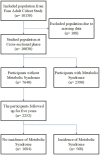The association between energy-adjusted dietary inflammatory index and metabolic syndrome and its mediatory role for cardiometabolic diseases: a prospective cohort study
- PMID: 39161908
- PMCID: PMC11330808
- DOI: 10.3389/fnut.2024.1429883
The association between energy-adjusted dietary inflammatory index and metabolic syndrome and its mediatory role for cardiometabolic diseases: a prospective cohort study
Abstract
Background: Metabolic syndrome (MetS) is a collection of medical conditions that elevate the chance of cardiovascular disease. An unhealthy diet is a major risk factors for MetS through different mechanisms, especially systemic chronic inflammation.
Objective: This study aimed to investigate the effect of dietary inflammatory potential on MetS incidence and the role of MetS in the association between Energy-adjusted dietary inflammatory index (E-DII) and cardiometabolic diseases.
Methods: In this prospective cohort study, 10,138 participants were recruited. All participants were divided into MetS or non-MetS groups based on the Adult Treatment Panel III criteria. The E-DII was used to assess the inflammatory potential of diet. After excluding the participants with MetS at baseline, 2252 individuals were followed for 5 years (longitudinal phase), and the effect of E-DII on MetS incidence was investigated using logistic regression models (p-value <0.05).
Results: The cohort's mean age (45.1% men) was 48.6 ± 10.0 years. E-DII ranged from -6.5 to 5.6 (mean: -0.278 ± 2.07). Higher E-DII score had a 29% (95%CI: 1.22-1.36) increased risk for incidence of MetS and its components during five-year follow-up. Also, E-DII was significantly associated with the prevalence of MetS (OR = 1.55, 95%CI: 1.51-1.59). Among MetS components, E-DII had the strongest association with waist circumference in the cross-sectional study (OR = 2.17, 95%CI: 2.08-2.25) and triglyceride in the longitudinal study (OR = 1.19, 95%CI: 1.13-1.25). The association between E-DII and MetS was consistent in both obese (OR = 1.13, 95%CI:1.05-1.21) and non-obese (OR = 1.42, 95%CI: 1.27-1.60) individuals and stronger among non-obese participants. Additionally, MetS mediated the association between E-DII and hypertension, diabetes, and myocardial infarction.
Conclusion: In conclusion, a pro-inflammatory diet consumption is associated with a higher risk of MetS and its components. Furthermore, a pro-inflammatory diet increases the risk of cardiometabolic diseases. The higher E-DII had a stronger association with MetS, even among normal-weight individuals.
Keywords: diabetes; dietary inflammatory index; inflammation; metabolic syndrome; myocardial infarction; stroke.
Copyright © 2024 Pourmontaseri, Sepehrinia, Kuchay, Farjam, Vahid, Dehghan, Homayounfar, Naghizadeh and Hebert.
Conflict of interest statement
The authors declare that the research was conducted in the absence of any commercial or financial relationships that could be construed as a potential conflict of interest.
References
-
- Grundy SM, Brewer HB, Jr, Cleeman JI, Smith SC, Jr, Lenfant C. Definition of metabolic syndrome: report of the National Heart, Lung, and Blood Institute/American Heart Association conference on scientific issues related to definition. Circulation. (2004) 109:433–8. doi: 10.1161/01.CIR.0000111245.75752.C6 - DOI - PubMed
-
- Lee H-S. Maternal nutrition, epigenetic programming and metabolic syndrome. Nutr Epigenomics. (2019) 1:153–66. doi: 10.1016/B978-0-12-816843-1.00010-2 - DOI
LinkOut - more resources
Full Text Sources


